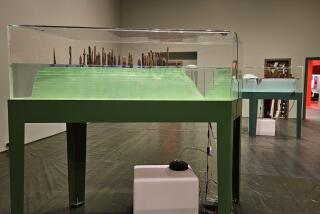DANCE REVIEW : Beth Soll and Company at Santa Monica Museum
- Share via
Without question, Beth Soll puts her vision onstage. In all three pieces presented Thursday at the Santa Monica Museum of Art, this Boston-based choreographer revealed the same emphasis on physical tension (especially a stretched, rigid spine), on arbitrary manipulation and absolute control.
Her pieces ricocheted between arduous activity and clenched pauses, small-scale gesture and expansive locomotion, stiff (often dislocated) physicalities and compulsive slumps or falls.
But the contrasts never seemed organic or logical so much as an exercise of power.
When Soll chose an appropriate subject--a repressive social order, for example, in “A Shaker Dance”--her method acquired a persuasive dramatic context. Here, to John Adams’ “Shaker Loops,” Soll and six others stalked and collapsed, surged into patterns suggesting social dance and ran in circles, framed by Katherine Finkelpearl’s remarkable setting: a free-standing, three-sided structure of white muslin, with eight portals leading to the stage and innumerable corners, corridors and antechambers where individuals could be strikingly isolated.
Significantly, the choreography proved just as unyielding, and Soll’s hard-working company just as shackled to an inescapable ordeal, in “Sanddance,” a piece supposedly inspired by aboriginal culture.
Here, to a score by Richard Cornell, five dancers continually cupped their hands over their eyes as if peering at a distant horizon. But the outdoors, and any concept of natural motion, remained very distant from this relentlessly stylized creation.
Indeed, the occasional animal cries and mime-references to spirituality (Pieta-poses showing Soll mothering the other women, one by one) only heightened a sense of profound disconnection.
The solo “Reentry” (music by David Stringham) featured another program note with religious connotations and more locked-down dancing--this time defining archetypal and sometimes deliberately archaic Earthmother iconography. However, a style that substitutes formal limb-signals for an involved, expressive lower torso and pelvis can’t speak coherently about sexuality any more than it can suggest an aboriginal world view.
Soll’s grimly purposeful work (on view through Sunday) may be refreshing as an alternative to the lax indulgence of some Southern California modern dance, but ultimately it is no more satisfying.
More to Read
The biggest entertainment stories
Get our big stories about Hollywood, film, television, music, arts, culture and more right in your inbox as soon as they publish.
You may occasionally receive promotional content from the Los Angeles Times.










